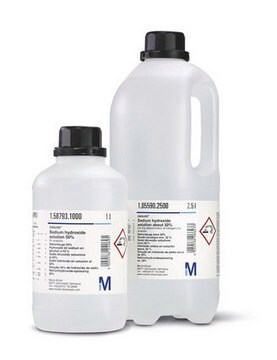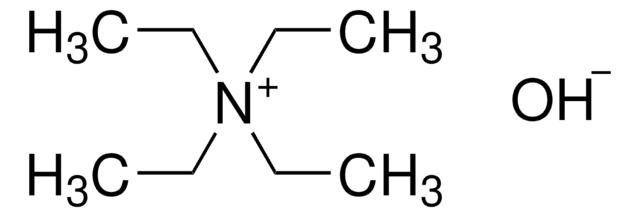1.08124
Tetramethylammonium hydroxide solution
c(C₄H₁₃NO)=0.1 mol/l (0.1 N) in 2-propanol/methanol, ready-to-use volumetric solution for titration in non-aqueous media, Titriplex®
About This Item
Produtos recomendados
Nome do produto
Tetramethylammonium hydroxide solution, in 2-propanol/methanol for titrations in non-aqueous media c(C4H13NO)=0.1 mol/l (0.1 N), Titripur®
Nível de qualidade
linha de produto
Titripur®
Formulário
liquid
qualidade
Analyzed in our ISO 17025 accredited QC lab
adequação da reação
reaction type: Acid-base reactions
reaction type: Redox Reactions
concentração
0.1 M
técnica(s)
titration: suitable
pH
14 (20 °C in H2O)
temperatura de transição
flash point 15 °C
densidade
0.79 g/cm3 at 20 °C
temperatura de armazenamento
15-25°C
Categorias relacionadas
Aplicação
- An Approach Based on an Increased Bandpass for Enabling the Use of Internal Standards in Single Particle ICP-MS: Application to AuNPs Characterization.: This study by Bazo et al. (2023) explores the use of Tetramethylammonium hydroxide solution to enhance internal standard applications in single particle ICP-MS for gold nanoparticle characterization. This method improves accuracy and reliability in nanoparticle detection (Bazo et al., 2023).
- Titanium dioxide nanoparticles assessment in seaweeds by single particle inductively coupled plasma - Mass spectrometry.: López-Mayán et al. (2022) utilized Tetramethylammonium hydroxide solution for the assessment of titanium dioxide nanoparticles in seaweeds. This approach allows for precise quantification and analysis of nanoparticles in complex matrices (López-Mayán et al., 2022).
- Determination of selenite and selenomethionine in kefir grains by reversed-phase high-performance liquid chromatography-inductively coupled plasma-optical emission spectrometry.: Bodur et al. (2021) used Tetramethylammonium hydroxide solution to effectively separate and quantify selenite and selenomethionine in kefir grains, demonstrating its utility in food chemistry applications (Bodur et al., 2021).
- Application of TMAH thermochemolysis to the detection of nucleobases: Application to the MOMA and SAM space experiment.: He et al. (2019) applied Tetramethylammonium hydroxide solution in thermochemolysis for detecting nucleobases in space mission experiments, demonstrating its application in astrobiology and space chemistry (He et al., 2019).
Características e benefícios
This volumetric solution is analyzed by our calibration laboratory D-K-15185-01-00 which is accredited according to DIN EN ISO/IEC 17025 for analysis of amount-of-substance concentrations in volumetric solutions by DAkkS (Deutsche Akkreditierungsstelle - German National Accreditation Body). The accreditation certificate can be found at www.sigmaaldrich.com/ISO17025.
Nota de análise
Amount-of-substance concentration 0.0994 - 1.006 mol/L
Measurement uncertainty ± 0.0004 mol/L
Traceability NIST SRM
The concentration is determined by volumetric titration and refers to 20°C.
The amount-of-substance concentration of this volumetric solution is traceable to a primary standard reference material (SRM) from the National Institute of Standards and Technology, Gaithersburg, USA (NIST SRM 350 benzoic acid) by means of volumetric standard benzoic acid (article number 1.02401), certified reference material according to ISO 17034, analyzed by our accredited calibration laboratory of Merck KGaA, Darmstadt, Germany according to DIN EN ISO/IEC 17025. The uncertainty is expressed as expanded measurement uncertainty with a coverage factor k=2 covering a confidence level of 95%.
Note: The titer is a correction factor to correct for variations of the volumetric solution, the titration equipment, the temperature and other laboratory conditions. For correct titration results it is recommended to determine a titer with the laboratory specific equipment and under laboratory specific conditions directly after opening a new bottle and at regular time intervals.
Informações legais
produto relacionado
Palavra indicadora
Danger
Frases de perigo
Declarações de precaução
Classificações de perigo
Acute Tox. 3 Dermal - Acute Tox. 3 Oral - Acute Tox. 4 Inhalation - Eye Dam. 1 - Flam. Liq. 2 - Skin Corr. 1 - STOT RE 2 Dermal - STOT SE 1 - STOT SE 3
Órgãos-alvo
Central nervous system
Código de classe de armazenamento
3 - Flammable liquids
Classe de risco de água (WGK)
WGK 2
Ponto de fulgor (°F)
59.0 °F
Ponto de fulgor (°C)
15 °C
Certificados de análise (COA)
Busque Certificados de análise (COA) digitando o Número do Lote do produto. Os números de lote e remessa podem ser encontrados no rótulo de um produto após a palavra “Lot” ou “Batch”.
Já possui este produto?
Encontre a documentação dos produtos que você adquiriu recentemente na biblioteca de documentos.
Os clientes também visualizaram
Nossa equipe de cientistas tem experiência em todas as áreas de pesquisa, incluindo Life Sciences, ciência de materiais, síntese química, cromatografia, química analítica e muitas outras.
Entre em contato com a assistência técnica


![Solução de hidróxido de tetra-n-butilamônio in 2-propanol/methanol for titrations in nonaqueous media c[(C4H9)4NOH] = 0.1 mol/l (0.1 N), Titripur®, reag. USP](/deepweb/assets/sigmaaldrich/product/images/217/795/18cba546-7592-4bb4-8b67-0b4b229e0a2f/640/18cba546-7592-4bb4-8b67-0b4b229e0a2f.jpg)







